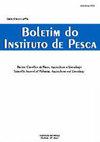Diet of Psalidodon aff. fasciatus (Cuvier, 1819) (Teleostei: Characidae) in a neotropical river before reservoir formation
IF 0.6
4区 农林科学
Q4 FISHERIES
引用次数: 0
Abstract
The main objective of this study was to identify spatial and seasonal variations on the diet of Psalidodon aff. fasciatus from the Tibagi River (South Brazil) before the construction of the Tibagi Montante hydropower plant. Fish were collected quarterly between October 2017 and July 2019. 536 stomachs containing feeding items and identified to the lowest taxonomic level as possible have been analyzed. Results showed that plants, Hymenoptera, and insect parts in general were the most consumed items. The analysis of feeding strategy showed a diet based on rare items but with individuals varying among specialist, generalist, and opportunistic trends depending on the season. The non-metric multidimensional scaling (NMDS) revealed diet overlap in both spatial and seasonal terms, which was confirmed by the permutational analysis of variance (PERMANOVA). The indicator value analysis (IndVal) identified 15 items as the most important components of this species’ diet such as superior plants, Hymenoptera and insect parts. Therefore, before the formation of the reservoir, P. aff. fasiatus could be characterized as predominantly herbivore with a strong trend for insectivory. Across seasons, this species had a specialized diet all year, although with more specialized preferences in the spring when the consumption of plants was increased.在水库形成之前,新热带河流中的一种新热带河鲈的食性(居维叶,1819)(鲈形目:鱼科)
本研究的主要目的是确定在Tibagi Montante水电站建设之前,Tibagi河(巴西南部)的palidodon affer . fasciatus饮食的空间和季节变化。在2017年10月至2019年7月期间,每季度收集一次鱼。已对536个装有饲料的胃进行了分析,并尽可能确定了最低的分类水平。结果表明,植物、膜翅目昆虫和昆虫部位是昆虫的主要食用量。对进食策略的分析显示,它们的饮食以稀有物品为基础,但个体根据季节的不同,在专家、通才和机会主义趋势之间存在差异。非度量多维尺度(NMDS)揭示了饮食在空间和季节上的重叠,并通过排列方差分析(peromova)证实了这一点。指标值分析(IndVal)鉴定出优势植物、膜翅目昆虫和昆虫部分等15项是其最重要的食性成分。因此,在储层形成之前,斑蝽可表现为草食为主,食虫倾向较强。在不同的季节,这个物种全年都有一个专门的饮食,尽管在春天,当植物的消耗增加时,有更专门的偏好。
本文章由计算机程序翻译,如有差异,请以英文原文为准。
求助全文
约1分钟内获得全文
求助全文
来源期刊

Boletim do Instituto de Pesca
FISHERIES-ZOOLOGY
CiteScore
0.80
自引率
0.00%
发文量
24
审稿时长
>12 weeks
期刊介绍:
To publish original articles of research and short communications in the following áreas: Fisheries, Aquaculture, Zootechnology, Limnology, Oceanography, Biology and Pathology of aquatic organisms. The publication depends on the approval of the Editorial Board, based on the peer review.
 求助内容:
求助内容: 应助结果提醒方式:
应助结果提醒方式:


